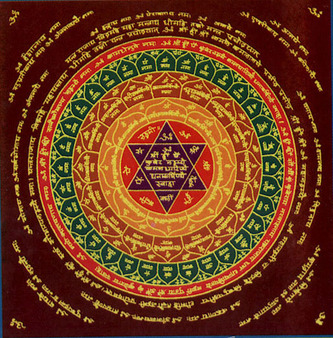
The International Hindu Calendar is no ordinary calendar or almanac. It is far more complex than the simple Gregorian calendar normally used in the West and far more useful. It is patterned after the traditional panchangams used throughout Sri Lanka and South India which employ the Nirayana (sidereal) zodiacal system. Panchanga, a Sanskrit word, means "five limbs," which refers to the fact that every panchangam includes the five basic elements of tithi (lunar day), nakshatra (the constellation the moon is aligned with), karana (half-day), yoga (a particular angle of the sun and moon) and vara or vasara (solar weekday). Panchangams furnish other astronomical information which is extensively used by astrologers, as well as the times of all forthcoming religious events. Most modern panchangams, such as the Internatinal Hindu Calendar, also include Gregorian (Western) calendar information, which has been adopted as the unified world standard.
The basic principles of both eastern and western calendars were originally conceived thousands of years ago by great masters in Hindu astronomy, a field of knowledge which they regarded as synonymous with Nirayana, or sidereal (fixed zodiac), astrology. Their plane of observation was quite different from that of modern astronomers and scientists, for they were adepts in the mystical art of yoga. They perceived the mysteries of the planets and stars from an inner perspective and brought forth several detailed astronomical texts. From these manuscripts modern Hindu calendars, such as this calendar, have evolved. Of course, inner truths are not confined to rishis of the past, and several aspects of this panchangam were unfolded in recent times by Satguru Sivaya Subramuniyaswami to assist humanity in the technological age.
The study and daily use of the Hindu Calendar helps the conscientious individual to understand and monitor the prevailing forces of each day. With this knowledge, he or she is able to flow with the river of life, "creatively alive and in tune with the universe." We are all well aware of the concepts of "good timing" and "bad timing" and how at certain times everything seems to be flowing along smoothly, while at other moments things "just don't come together." The calendar provides knowledge to understand such phenomena, so that one can take advantage of auspicious moments and avoid new undertakings when the creative forces are on the wane.
For the full article and more info click the picture above.
The basic principles of both eastern and western calendars were originally conceived thousands of years ago by great masters in Hindu astronomy, a field of knowledge which they regarded as synonymous with Nirayana, or sidereal (fixed zodiac), astrology. Their plane of observation was quite different from that of modern astronomers and scientists, for they were adepts in the mystical art of yoga. They perceived the mysteries of the planets and stars from an inner perspective and brought forth several detailed astronomical texts. From these manuscripts modern Hindu calendars, such as this calendar, have evolved. Of course, inner truths are not confined to rishis of the past, and several aspects of this panchangam were unfolded in recent times by Satguru Sivaya Subramuniyaswami to assist humanity in the technological age.
The study and daily use of the Hindu Calendar helps the conscientious individual to understand and monitor the prevailing forces of each day. With this knowledge, he or she is able to flow with the river of life, "creatively alive and in tune with the universe." We are all well aware of the concepts of "good timing" and "bad timing" and how at certain times everything seems to be flowing along smoothly, while at other moments things "just don't come together." The calendar provides knowledge to understand such phenomena, so that one can take advantage of auspicious moments and avoid new undertakings when the creative forces are on the wane.
For the full article and more info click the picture above.
 RSS Feed
RSS Feed
